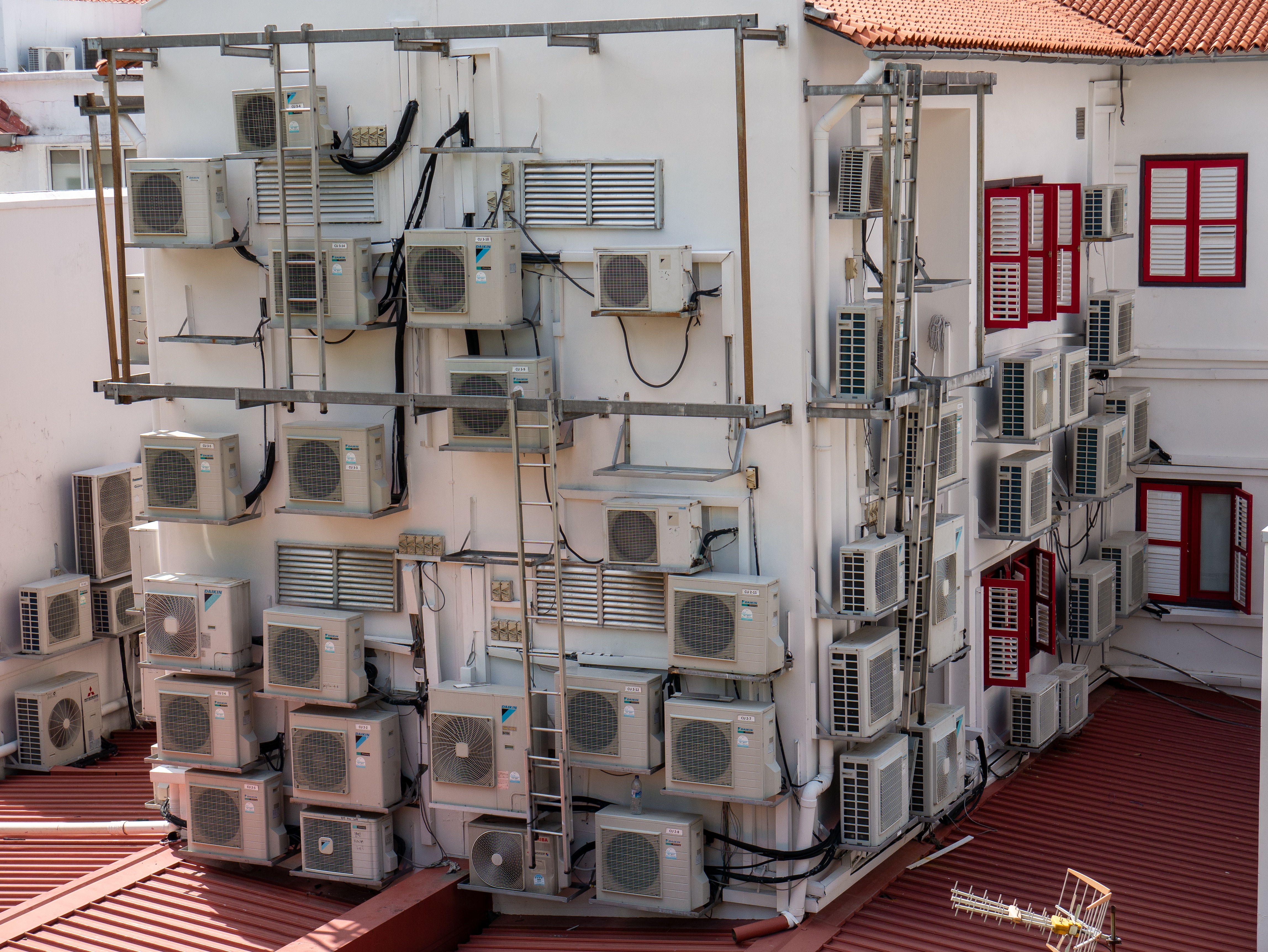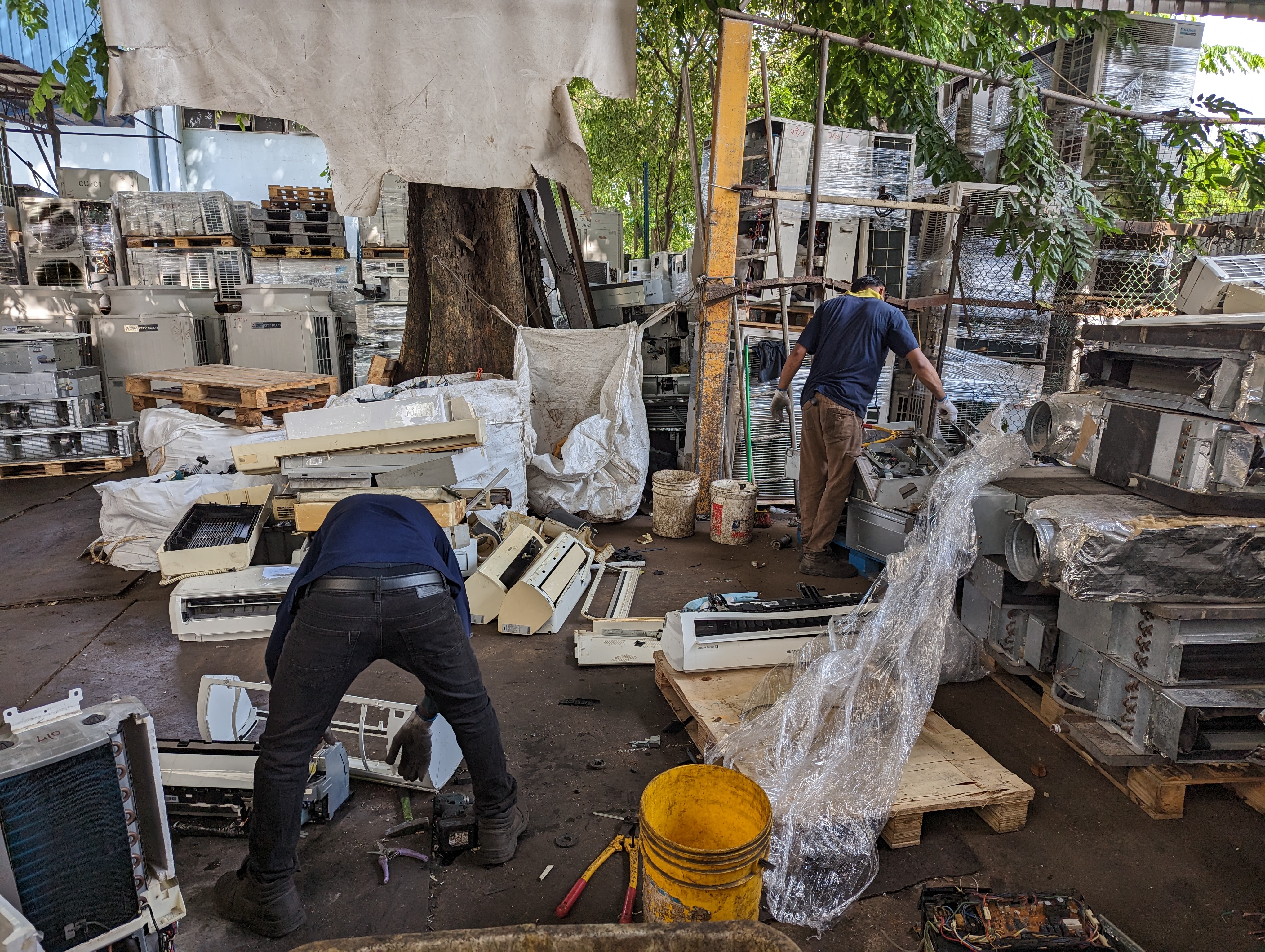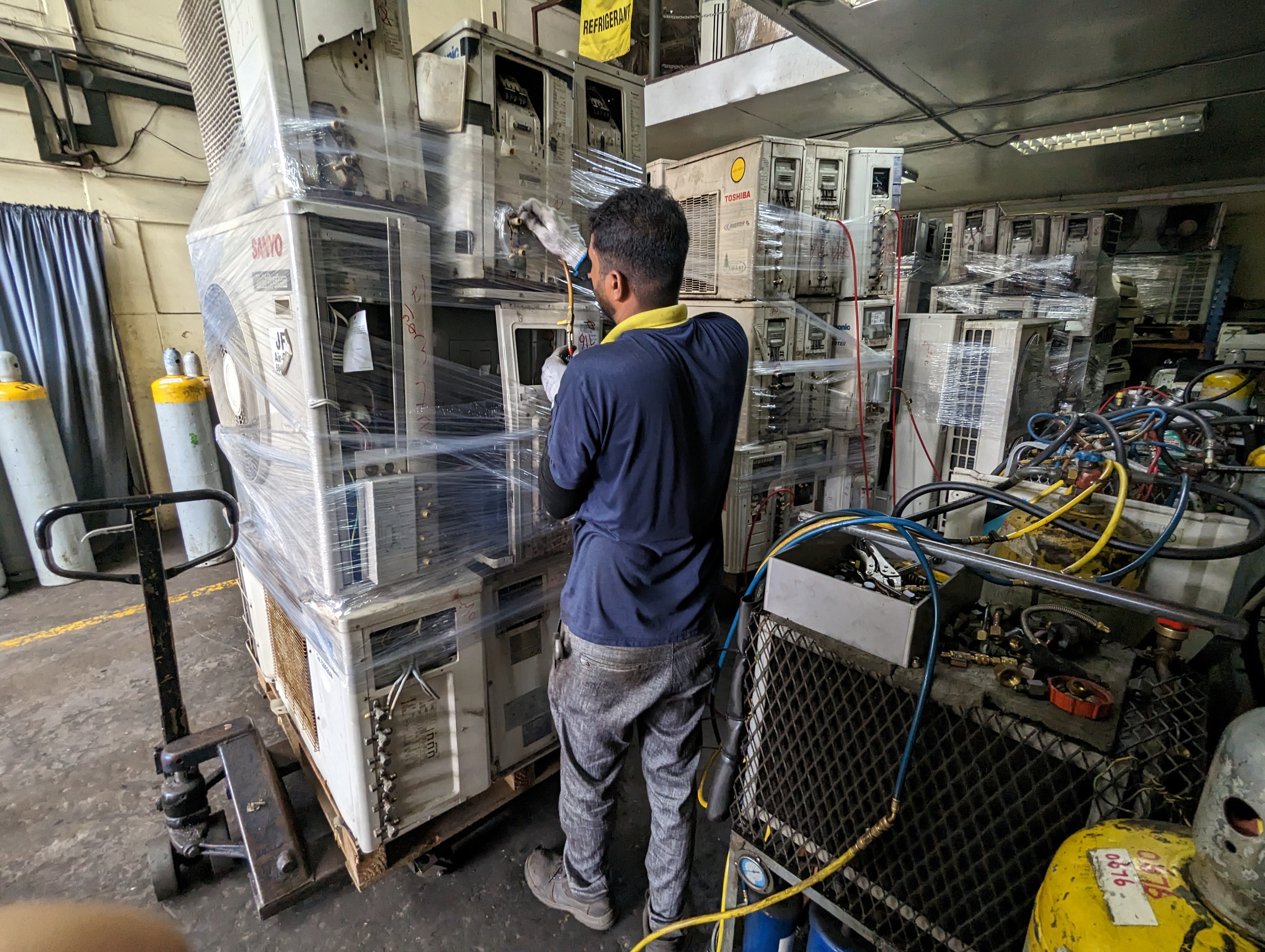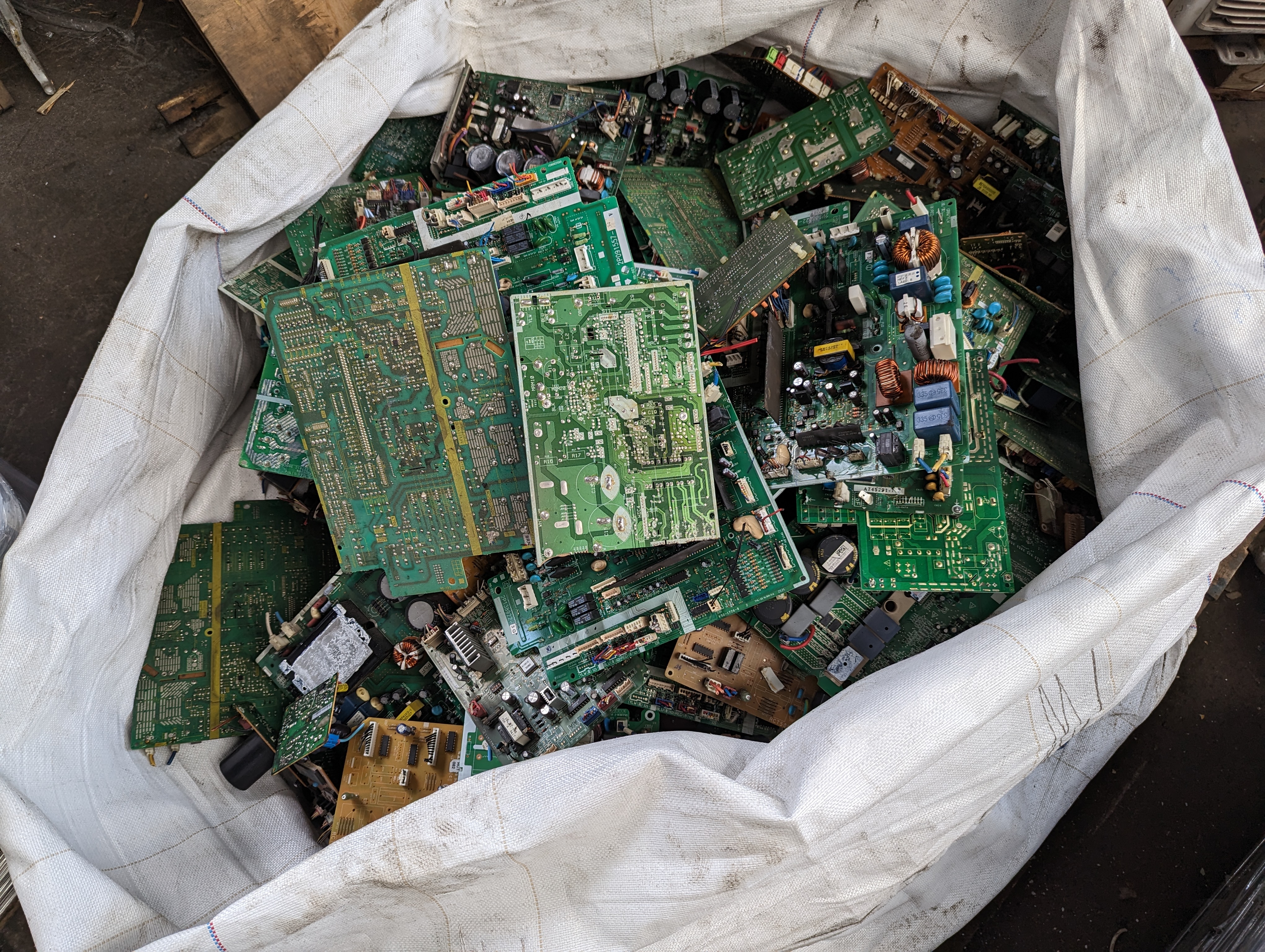In an otherwise unheralded place, a scrapyard in Singapore has taken on an immense task: capturing greenhouse gases thousands of times more potent than carbon dioxide.
Cheng Hwa Private Trading Limited sits along an intersection in Singapore’s Defu Industrial Park, surrounded by furniture warehouses and paint stores. Cheng Hwa’s lot – an amalgam of concrete walls, corrugated metal sheds, and plastic tents – has seen better days. Vines and tree branches engulf the exterior walls. Gasoline fumes and cigarette smoke saturate the air.
Cheng Hwa is one of Singapore’s largest scrapyards dedicated to air conditioning equipment, processing close to 60,000 air conditioners each year. Scrapyard employees, dressed in steel-toed boots and navy-blue polo shirts, stand in clusters around the facility, working in teams to disassemble equipment.
Workers suck out refrigerant gases from systems using a large vacuum pump and use drills and crowbars to disassemble equipment. They claim valuable components, like the compressor, copper tubes, and circuit boards, and toss the rest – mostly miscellaneous plastics – in a heap for recycling. Along the perimeter of the facility, thousands of air conditioners wait to be scrapped. They are stacked on wooden pallets, towering two stories above the ground.

Air conditioning is ubiquitous in Singapore, a country whose founding father once heralded air conditioning for “changing the nature of civilization by making development possible in the tropics.” It’s common to walk through an alley and find the backsides of buildings completely covered in air conditioners, expelling heat that raises the temperature on the street by several degrees Celsius.
Singapore, one of the world’s richest countries on a per-capita basis, is a prelude for air conditioning adoption in the Southeast Asian region. By 2040, the number of air conditioners in use across the region is expected to quadruple, driven largely by rising incomes and a hotter climate.
Although air conditioning is critical for development and climate change adaptation, it also worsens the climate crisis. Currently, air conditioners are responsible for 4 percent of global emissions, double the emissions of the entire aviation industry. By 2040, air conditioning could account for 30 percent of Southeast Asia’s energy use. And air conditioners still use potent refrigerant gases that are hundreds to thousands of times more potent than CO2, accounting for a billion tons of CO2e emissions each year.

Lin Zihan, Chengwha’s manager, is a young, wiry man, who furrows his brow when talking about the scrapyard’s operations.
“It’s inefficient,” Lin said. “It’s all manual labor.”
One driver of operational inefficiencies is the refrigerant recovery process, which adds significant time and labor requirements to the scrapping process. Some other scrapyards skip this process and release the refrigerant into the atmosphere.
Across the globe, refrigerants are almost always released into the atmosphere at equipment end-of-life, even though many national governments nominally mandate refrigerant recovery. In practice, regulators have struggled to detect and enforce non-compliance. Refrigerant is colorless and odorless, and the venting process takes only a few seconds.

Even Singapore, which is famous for its impeccable streets and effective crime reduction, has struggled to improve its own refrigerant recovery rates. More than 90 percent of refrigerant in end-of-life equipment is vented, as opposed to recovered, in Singapore each year.
Unsurprisingly, venting is also driven by the unit economics for refrigerant gas and recovery practices. There’s little demand for recovered refrigerant, especially in regions such as Southeast Asia, where it’s still cheap to import virgin gases from China or India.
Recovering refrigerant also requires physical capital, labor, and time. Since scrapyards performing recoveries don’t make very much money from selling their recovered refrigerant, recoveries erode their profit margins. Equipment owners want to sell their broken air conditioners to scrapyards who will pay them the most money for them. Since compliant scrapyards have more costs to cover, they can’t pay consumers as much as the scrapyards that vent refrigerant. That means that fewer air conditioners make it to compliant scrapyards, and less refrigerant recovery happens overall.

Although refrigerant recoveries are a net financial loss for Cheng Hwa, they’re a win for the climate. In a year, Cheng Hwa recovers 48 tons of refrigerant, equivalent in climate impact to 96,000 metric tons of CO2e, or 1,200 tanker trucks of gasoline.
“What would be ideal is better government enforcement,” Lin said. “It would also help to have better equipment – faster recovery machines, and technology that could test gases for their type and purity.”
Without government enforcement, environmental responsibility is a penalty for businesses.
Previously, our HFC team has advocated for carbon credits as a way of financing refrigerant recovery and abatement, particularly in developing (“Article 5”) countries. Although Singapore, as an Article 5 country, is eligible under our methodology, an even better long-term solution could lie with regulators. Singapore’s E-waste law currently mandates scrapping of air conditioners but focuses more on recovery of metals than refrigerants. A government-led push to increase refrigerant recoveries in the program could be effective. Singapore, which has a smaller geographic footprint than most cities, has only a handful of scrapyards to monitor for recoveries.

Challenges of refrigerant recovery in Singapore are just beginning. Over the past decade, the average age of air conditioners entering Cheng Hwa’s facility has decreased considerably, with 2- to 5-year-old air conditioners commonly arriving as scrap.
“The quality of the machines is much worse than it used to be,” Lin explained. He nodded toward a pallet of air conditioners, all manufactured between 2020 and 2021.
Most of this newer equipment is suspected to have broken due to faulty circuit boards, which help air conditioning systems autonomously regulate indoor temperatures. It’s cheaper and easier, at least in Singapore, for equipment owners to sell their equipment for scrap than getting components replaced.
Shorter equipment lifetimes are a looming problem for refrigerant emissions. Countries in Southeast Asia haven’t yet entered HFC phasedown prescribed by the Kigali Amendment, meaning that virgin refrigerants can enter the economy, essentially without limit, until the end of the decade. Faster turnover in equipment also means a growing scrapping business for Cheng Hwa, but financial losses of a greater magnitude from refrigerant recovery.
“I used to think that one day all of this would stop,” Lin said, gesturing to the pallets of air conditioners moving in and out of the yard. “But every day – every single day – more units come in.”
He glanced out toward the road, where a forklift was inching toward the lot, carrying a bale of air conditioners. “It really just never stops.”

